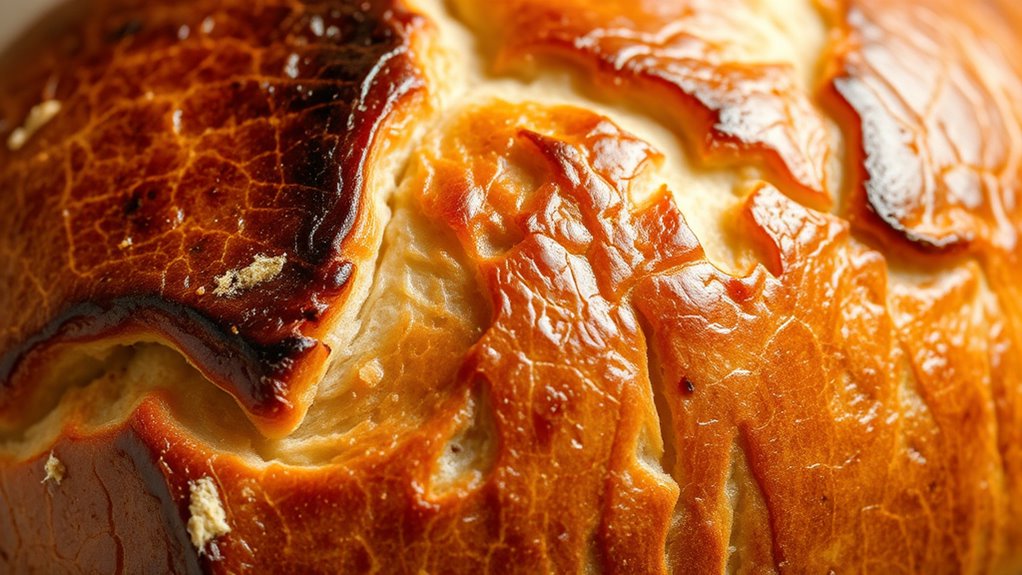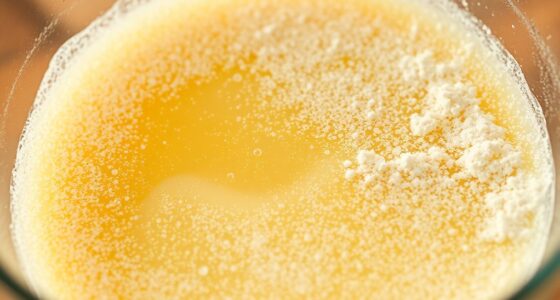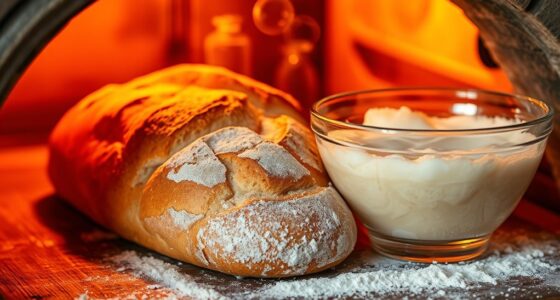The chemistry behind baking bread’s perfect crust involves heat-triggered reactions like the Maillard process, which creates flavor and color by reacting amino acids and sugars. Caramelization of sugars adds sweetness and a deep hue, while moisture loss from high heat results in a crispy exterior. Ingredients and technique influence texture, with temperature controlling browning and caramelization. Understanding these chemical processes helps you achieve a beautifully balanced crust—continue exploring to reveal even more baking secrets.
Key Takeaways
- Heat drives Maillard reactions and caramelization, producing flavor, color, and crust texture in baked bread.
- Proper oven temperature controls moisture evaporation, affecting crust thickness, crispness, and browning.
- Higher temperatures accelerate Maillard browning and sugar caramelization, enhancing crust flavor and golden appearance.
- Ingredient ratios, especially hydration and fats, influence moisture content, impacting crust softness or crunchiness.
- Techniques like preheating and moisture management optimize heat transfer and crust development during baking.
The Role of Heat in Crust Formation
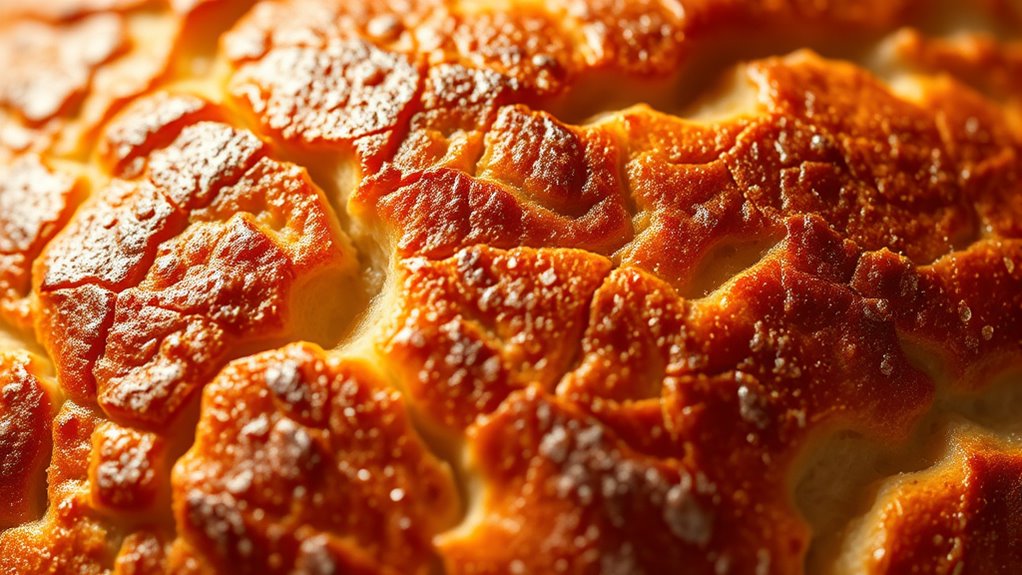
Heat is the key driver behind the formation of a bread’s crust. When you set your oven to the right temperature, it influences how quickly moisture evaporates and how the crust develops. A higher oven temperature accelerates crust formation, resulting in a thicker, more substantial crust. Conversely, a lower temperature produces a thinner crust with a softer texture. The oven’s heat causes the surface of the dough to undergo physical changes, creating that initial crackle and texture you see. Understanding oven temperature is essential for achieving consistent baking results. Additionally, the chemical reactions that occur during baking, such as caramelization and Maillard browning, are heavily influenced by oven heat and contribute to crust color and flavor. Controlling oven temperature allows you to fine-tune crust thickness—setting it too high might burn the outside before the inside is baked through, while too low can leave you with a pale, underdeveloped crust. Proper heat management is crucial because it affects how heat is transferred during baking, ensuring your bread develops the desired texture and flavor. Mastering heat guarantees your bread’s crust is just the right balance of crispness and flavor.
Maillard Reaction: Flavor and Color Development
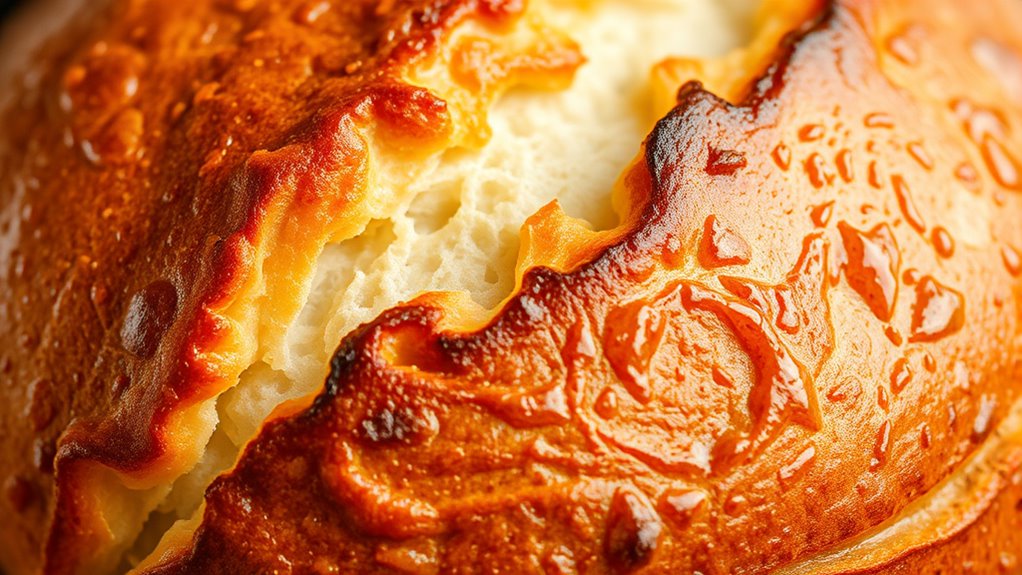
As the crust forms and browns, a complex chemical reaction takes center stage: the Maillard reaction. This process occurs when amino acids and reducing sugars react under heat, creating the rich flavors and appealing color you associate with a perfect crust. Sourdough fermentation enhances this reaction by increasing acidity, which influences crust thickness and enhances flavor development. The Maillard reaction contributes to the depth of aroma and the golden hue, making each bite more satisfying. To understand its impact, consider this table:
| Factor | Effect |
|---|---|
| Sourdough fermentation | Boosts flavor complexity and crust color |
| Temperature | Accelerates Maillard reaction |
| Moisture content | Affects browning rate |
| Crust thickness | Alters intensity of flavor and color |
| pH level | Influences the reaction’s progression |
This reaction is key to achieving that irresistible crust. Understanding the chemistry behind it helps bakers optimize their process for perfect results. Additionally, precise control of temperature during baking ensures the Maillard reaction proceeds optimally, resulting in a beautifully browned crust. Recognizing how pH level influences this process allows bakers to adjust ingredients for desired outcomes.
Caramelization of Sugars in Bread Dough

Caramelization occurs when the sugars in bread dough are heated to high temperatures, causing them to break down and form new compounds that contribute to the crust’s rich flavor and appealing color. As the sugars heat up, they undergo sugar crystallization, creating a complex mixture of caramelized molecules. This process results in the formation of a distinct caramel layer on the surface, giving the crust its characteristic sweetness and deep hue. During caramelization, the sugars dehydrate and polymerize, developing flavors ranging from nutty to toasty. The formation of this caramel layer is vital for the crust’s texture and taste, enhancing the overall baking experience. Proper temperature control guarantees even caramelization without burning, giving your bread that perfect balance of flavor and crust color. Additionally, understanding baking chemistry can help bakers optimize their techniques for consistently perfect results, especially when managing heat levels to prevent burning. Recognizing the importance of heat management can lead to more precise control over the caramelization process, ensuring optimal crust development.
The Impact of Ingredients on Crust Texture
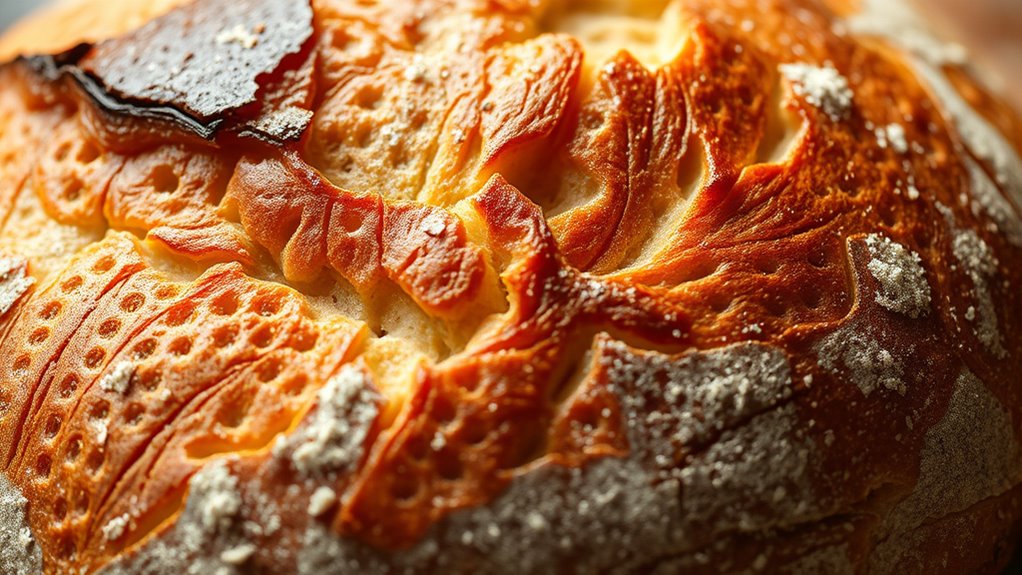
The ingredients you choose directly influence the texture of your bread’s crust. Adjusting ingredient ratios impacts crust moisture, which in turn affects crispiness and chewiness. For example, higher hydration levels increase moisture, creating a softer, less crunchy crust, while lower hydration yields a crisper exterior. The table below highlights how different ingredients influence crust texture:
| Ingredient | Effect on Crust Moisture | Resulting Texture |
|---|---|---|
| Water | Increases moisture | Softer, chewier crust |
| Flour | Adds structure, affects moisture | Dense, crispy crust |
| Salt | Regulates moisture absorption | Balanced, firm crust |
| Sugar | Promotes browning, moisture retention | Slightly softer crust |
| Fats (oil/butter) | Reduce crust moisture | Softer, less crispy |
Balancing these ingredient ratios helps you tailor your crust for perfect texture.
Techniques to Enhance the Crispy Exterior

To achieve an irresistibly crispy crust, you need to employ specific baking techniques that promote rapid moisture loss and browning. Controlling oven humidity is essential; reducing steam early in baking encourages the crust to form quickly and become crisp. You can do this by removing steam sources or using a Dutch oven, which traps moisture initially but allows it to escape later. Additionally, dough hydration plays a critical role—higher hydration creates a thinner, more delicate crust that crisps better as excess moisture evaporates. Proper oven temperature is crucial for ensuring the Maillard reaction occurs efficiently, enhancing browning and flavor. Preheating your oven thoroughly ensures even heat transfer, aiding in crispness. Using a baking stone or steel can also help by providing consistent heat. These techniques work together to optimize moisture evaporation and browning, resulting in a satisfyingly crunchy exterior.
Frequently Asked Questions
How Does Humidity Affect the Bread Crust Formation Process?
Humidity effects play a big role in crust formation. When humidity is high, the moisture in the air adds crust moisture, making the crust softer and less crispy. Low humidity helps the crust dry out faster, resulting in a crunchier, firmer crust. You’ll notice that controlling humidity during baking influences the crust’s texture, giving you more control over whether your bread turns out with a chewy or crisp crust.
Can Different Types of Flour Change the Crust’s Texture and Appearance?
Did you know that using different flours can alter your bread’s crust? Whole wheat, for example, creates a denser, darker crust, while bread flour results in a sturdier, golden appearance. Different types of flour impact gluten development, affecting texture and appearance. They also influence flavor enhancement, giving your bread unique characteristics. So, experimenting with flours allows you to customize both crust texture and visual appeal, making each loaf uniquely yours.
What Role Does Steam Play in Creating a Shiny, Crispy Crust?
Steam effects your bread by creating a moist environment early in baking, which helps the crust shine and develop a beautiful gloss. It also aids in moisture retention, allowing the crust to become crispier and more flavorful. The steam delays crust formation, giving it time to expand fully, resulting in a crust crunch that’s tender yet firm. Without steam, you miss out on that shiny, crispy finish that makes artisan bread so appealing.
How Does Fermentation Time Influence Crust Thickness and Crunchiness?
Fermentation duration plays a key role in crust development, affecting both thickness and crunchiness. When you extend fermentation time, the dough develops more complex flavors and a stronger gluten network, leading to a thicker, more textured crust. Shorter fermentation results in a thinner, crisper crust. By adjusting fermentation duration, you control the crust’s crunchiness and overall thickness, ensuring your bread achieves the perfect balance of texture and flavor you desire.
Are There Specific Baking Vessel Materials That Improve Crust Quality?
Oh, sure, because your baking vessel’s material is secretly the magic wand for perfect crust quality. Cast iron, with its heat retention and even cooking, truly elevates your bread’s crust, giving it that irresistible crunch. Dutch ovens trap steam beautifully, resulting in a glossy, crispy crust. Meanwhile, ceramic or stoneware can also help achieve that bakery-quality finish. So, yes, choosing the right baking vessel material definitely impacts your crust’s texture and overall perfection.
Conclusion
Now that you understand the chemistry behind bread’s perfect crust, you might think achieving that crispy exterior is complex. But with the right techniques—like controlling oven heat, using the right ingredients, and timing—you can easily elevate your baking. Don’t worry if it takes a few tries; mastering these principles makes every loaf better. Keep experimenting, and soon you’ll be enjoying irresistibly crunchy, flavorful bread that impresses everyone. Happy baking!
